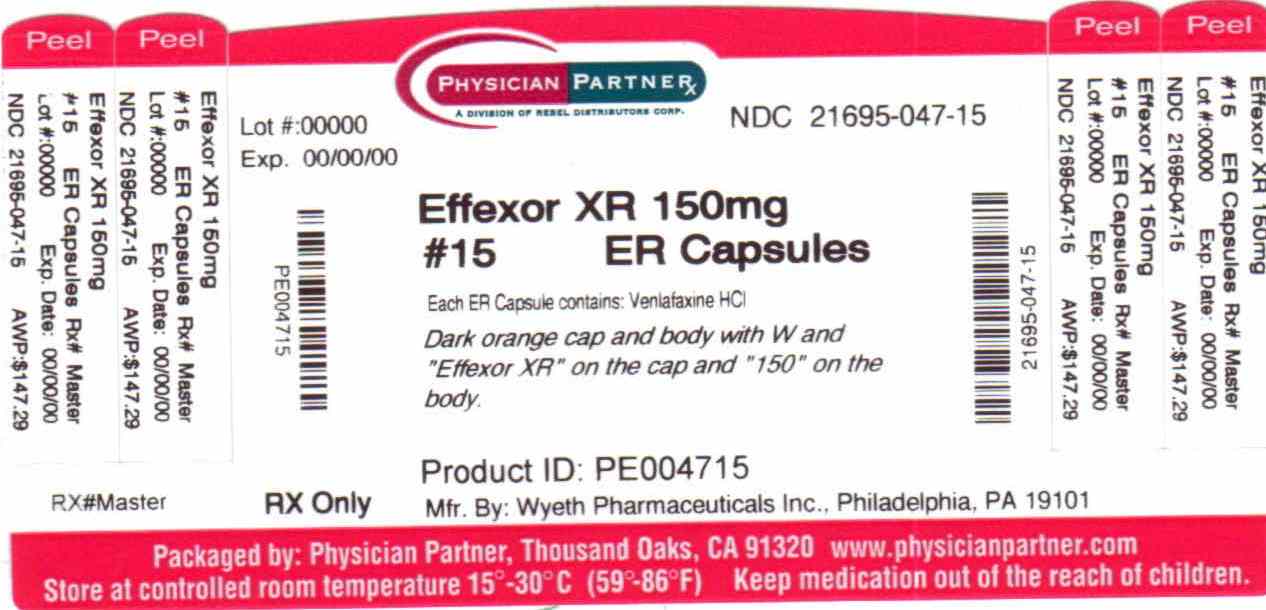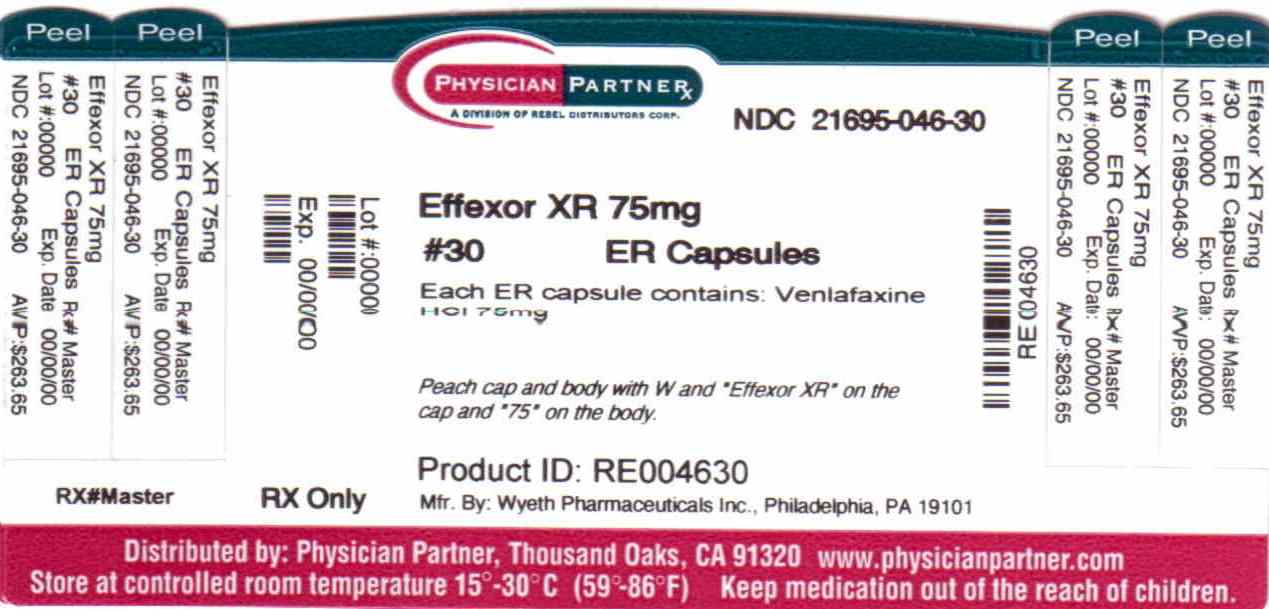It is a well known fact that breastfeeding is best source of nutrition for infants. Breast milk provides minerals, vitamins and antibodies in most acceptable format when they need it. Nutrition taken by mother passes to breast-milk and same thing applies to medicines taken by mothers. Not all drugs cause problem for baby but some do. Lets analyze if Effexor Xr Extended-release | Venlafaxine Hydrochloride Capsule, Extended Release is safe for baby while breastfed.
What is Effexor Xr Extended-release | Venlafaxine Hydrochloride Capsule, Extended Release ?
Major Depressive Disorder Effexor XR (venlafaxine hydrochloride) extended-release capsules is indicated for the treatment of major depressive disorder. The efficacy of Effexor XR in the treatment of major depressive disorder was established in 8- and 12-week controlled trials of adult outpatients whose diagnoses corresponded most closely to the DSM-III-R or DSM-IV category of major depressive disorder (see Clinical Trials ). A major depressive episode (DSM-IV) implies a prominent and relatively persistent (nearly every day for at least 2 weeks) depressed mood or the loss of interest or pleasure in nearly all activities, representing a change from previous functioning, and includes the presence of at least five of the following nine symptoms during the same two-week period: depressed mood, markedly diminished interest or pleasure in usual activities, significant change in weight and/or appetite, insomnia or hypersomnia, psychomotor agitation or retardation, increased fatigue, feelings of guilt or worthlessness, slowed thinking or impaired concentration, a suicide attempt or suicidal ideation. The efficacy of Effexor (immediate release) in the treatment of major depressive disorder in adult inpatients meeting diagnostic criteria for major depressive disorder with melancholia was established in a 4-week controlled trial (see Clinical Trials ). The safety and efficacy of Effexor XR in hospitalized depressed patients have not been adequately studied. The efficacy of Effexor XR in maintaining a response in major depressive disorder for up to 26 weeks following 8 weeks of acute treatment was demonstrated in a placebo-controlled trial. The efficacy of Effexor (immediate release) in maintaining a response in patients with recurrent major depressive disorder who had responded and continued to be improved during an initial 26 weeks of treatment and were then followed for a period of up to 52 weeks was demonstrated in a second placebo-controlled trial (see Clinical Trials ). Nevertheless, the physician who elects to use Effexor/Effexor XR for extended periods should periodically re-evaluate the long-term usefulness of the drug for the individual patient (see DOSAGE AND ADMINISTRATION ). Generalized Anxiety Disorder Effexor XR is indicated for the treatment of Generalized Anxiety Disorder (GAD) as defined in DSM-IV. Anxiety or tension associated with the stress of everyday life usually does not require treatment with an anxiolytic. The efficacy of Effexor XR in the treatment of GAD was established in 8-week and 6-month placebo-controlled trials in adult outpatients diagnosed with GAD according to DSM-IV criteria (see Clinical Trials ). Generalized Anxiety Disorder (DSM-IV) is characterized by excessive anxiety and worry (apprehensive expectation) that is persistent for at least 6 months and which the person finds difficult to control. It must be associated with at least 3 of the following 6 symptoms: restlessness or feeling keyed up or on edge, being easily fatigued, difficulty concentrating or mind going blank, irritability, muscle tension, sleep disturbance. Although the effectiveness of Effexor XR has been demonstrated in 6-month clinical trials in patients with GAD, the physician who elects to use Effexor XR for extended periods should periodically re-evaluate the long-term usefulness of the drug for the individual patient (see DOSAGE AND ADMINISTRATION ). Social Anxiety Disorder Effexor XR is indicated for the treatment of Social Anxiety Disorder, also known as Social Phobia, as defined in DSM-IV (300.23). Social Anxiety Disorder (DSM-IV) is characterized by a marked and persistent fear of 1 or more social or performance situations in which the person is exposed to unfamiliar people or to possible scrutiny by others. Exposure to the feared situation almost invariably provokes anxiety, which may approach the intensity of a panic attack. The feared situations are avoided or endured with intense anxiety or distress. The avoidance, anxious anticipation, or distress in the feared situation(s) interferes significantly with the person's normal routine, occupational or academic functioning, or social activities or relationships, or there is a marked distress about having the phobias. Lesser degrees of performance anxiety or shyness generally do not require psychopharmacological treatment. The efficacy of Effexor XR in the treatment of Social Anxiety Disorder was established in four 12-week and one 6-month placebo-controlled trials in adult outpatients with Social Anxiety Disorder (DSM-IV) (see Clinical Trials ). Although the effectiveness of Effexor XR has been demonstrated in a 6-month clinical trial in patients with Social Anxiety Disorder, the physician who elects to use Effexor XR for extended periods should periodically re-evaluate the long-term usefulness of the drug for the individual patient (see DOSAGE AND ADMINISTRATION ). Panic Disorder Effexor XR is indicated for the treatment of panic disorder, with or without agoraphobia, as defined in DSM-IV. Panic disorder is characterized by the occurrence of unexpected panic attacks and associated concern about having additional attacks, worry about the implications or consequences of the attacks, and/or a significant change in behavior related to the attacks. Panic disorder (DSM-IV) is characterized by recurrent, unexpected panic attacks, ie, a discrete period of intense fear or discomfort, in which four (or more) of the following symptoms develop abruptly and reach a peak within 10 minutes: 1) palpitations, pounding heart, or accelerated heart rate; 2) sweating; 3) trembling or shaking; 4) sensations of shortness of breath or smothering; 5) feeling of choking; 6) chest pain or discomfort; 7) nausea or abdominal distress; 8) feeling dizzy, unsteady, lightheaded, or faint; 9) derealization (feelings of unreality) or depersonalization (being detached from oneself); 10) fear of losing control; 11) fear of dying; 12) paresthesias (numbness or tingling sensations); 13) chills or hot flushes. The efficacy of Effexor XR in the treatment of panic disorder was established in two 12-week placebo-controlled trials in adult outpatients with panic disorder (DSM-IV). The efficacy of Effexor XR in prolonging time to relapse in panic disorder among responders following 12 weeks of open-label acute treatment was demonstrated in a placebo-controlled study (see CLINICAL PHARMACOLOGY, Clinical Trials ). Nevertheless, the physician who elects to use Effexor XR for extended periods should periodically re-evaluate the long-term usefulness of the drug for the individual patient (see DOSAGE AND ADMINISTRATION ).
Can I use Effexor Xr Extended-release | Venlafaxine Hydrochloride Capsule, Extended Release while breastfeeding?
Active ingredient in Effexor Xr Extended-release | Venlafaxine Hydrochloride Capsule, Extended Release is Venlafaxine and based on our analysis of Venlafaxine it appears that using Effexor Xr Extended-release | Venlafaxine Hydrochloride Capsule, Extended Release is safe in breastfeeding. Below is analysis of Venlafaxine while breastfeeding.
Statement of Manufacturer/Labeler about breastfeeding usage
Nursing Mothers Venlafaxine and ODV have been reported to be excreted in human milk. Because of the potential for serious adverse reactions in nursing infants from Effexor XR, a decision should be made whether to discontinue nursing or to discontinue the drug, taking into account the importance of the drug to the mother.
Effexor Xr Extended-release | Venlafaxine Hydrochloride Capsule, Extended Release Breastfeeding Analsys
SafeCAS Number: 93413-69-5
It is a reuptake-inhibitor of Serotonin and Norepinephrine, and a precursor of Desvenlafaxine. Excreted into breast milk in amounts that may be clinically significant, which has been found in the plasma of breastfed infants from treated mothers. However, side-effects in those infants have not been shown. Various studies failed to show short or long-term side-effects among infants whose mothers were on Venlafaxine, both on physical or psychomotor development. It may induce galactorrhea. The poor extrauterine adaptation that may appear in neonates just after birth when the pregnant woman has been treated with selective reuptake-inhibitors of Serotonin like Venlafaxine or Mirtazapine, is seen to be mild if the baby is breastfed. In the case report of a mother who was taking this medication during pregnancy, her infant had shown amelioration of symptoms due to Abstinence Syndrome after having been breastfed. Women who use antidepressant medication during pregnancy are in need of more support for breastfeeding since they are at risk for early weaning.
Effexor Xr Extended-release | Venlafaxine Hydrochloride Capsule, Extended Release Breastfeeding Analsys - 2
CAS Number: 93413-69-5

Infants receive venlafaxine and its active metabolite in breastmilk, and the metabolite of the drug can be found in the plasma of most breastfed infants; however, concurrent side effects have rarely been reported. Breastfed infants, especially newborn or preterm infants, should be monitored for excessive sedation and adequate weight gain if this drug is used during lactation, possibly including measurement of serum levels of desvenlafaxine (O-desmethylvenlafaxine), to rule out toxicity if there is a concern. However, newborn infants of mothers who took the drug during pregnancy may experience poor neonatal adaptation syndrome as seen with other antidepressants such as SSRIs or SNRIs. Use of venlafaxine during breastfeeding has been proposed as a method of mitigating infant venlafaxine withdrawal symptoms,[1][2] but this has not been rigorously demonstrated.
What should I do if already breastfed my kid after using Effexor Xr Extended-release | Venlafaxine Hydrochloride Capsule, Extended Release?
As usage of Effexor Xr Extended-release | Venlafaxine Hydrochloride Capsule, Extended Release is mostly safe while breastfeeding hence there should not be any concern. In case of any change in behavior or health of your baby you should inform your health care provider about usage of Effexor Xr Extended-release | Venlafaxine Hydrochloride Capsule, Extended Release else no further action is required.
My doctor has prescribed me Effexor Xr Extended-release | Venlafaxine Hydrochloride Capsule, Extended Release, what should I do?
Definitely, Effexor Xr Extended-release | Venlafaxine Hydrochloride Capsule, Extended Release is safe in lactation for baby. No wonder your doctor has recommended it.
If I am using Effexor Xr Extended-release | Venlafaxine Hydrochloride Capsule, Extended Release, will my baby need extra monitoring?
No extra baby monitoring required while mother is using Effexor Xr Extended-release | Venlafaxine Hydrochloride Capsule, Extended Release
Who can I talk to if I have questions about usage of Effexor Xr Extended-release | Venlafaxine Hydrochloride Capsule, Extended Release in breastfeeding?
US
National Womens Health and Breastfeeding Helpline: 800-994-9662 (TDD 888-220-5446) 9 a.m. and 6 p.m. ET, Monday through Friday
UK
National Breastfeeding Helpline: 0300-100-0212 9.30am to 9.30pm, daily
Association of Breastfeeding Mothers: 0300-330-5453
La Leche League: 0345-120-2918
The Breastfeeding Network supporter line in Bengali and Sylheti: 0300-456-2421
National Childbirth Trust (NCT): 0300-330-0700
Australia
National Breastfeeding Helpline: 1800-686-268 24 hours a day, 7 days a week
Canada
Telehealth Ontario for breastfeeding: 1-866-797-0000 24 hours a day, 7 days a week
Drug Brands with same Active ingredients



